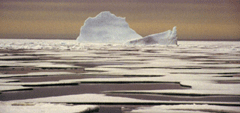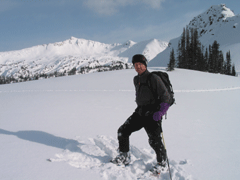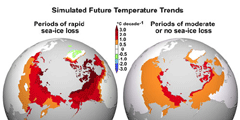Not-So-Perma Permafrost
Air Date: Week of June 27, 2008

New research shows melting sea ice caused by global warming may be causing permafrost to melt more quickly. Dr. Andrew Slater from the National Snow and Ice Data Center explains to host Bruce Gellerman that the warming could be having unintended consequences – both positive and negative - for the tundra ecoysystem.
Transcript
Well, if you lived in the Arctic you’d already notice the effects of climate change. The Arctic sea ice is melting at a rapid and accelerating pace and it’s having a dramatic effect on the permafrost, the permanently frozen tundra. That according to a new study by the National Center for Atmospheric Research. Andrew Slater from the National Snow and Ice Data Center in Boulder Colorado, worked on the study.

Dr. Andrew Slater is a research scientist at the National Snow and Ice Data Center. (Courtesy Andrew Slater, National Snow and Ice Data Center)
GELLERMAN: So you have the permafrost thawing. So what?
SLATER: That creates a lot of problems for infrastructure up in the north.
You’ve got roads that will become rather degraded, you’ve got buildings that can possibly collapse. States like Alaska are quite concerned about this because that can add a ten to twenty percent increase in the cost of maintaining infrastructure. And then the other real surprise package that we haven’t seen emerge yet but is definitely a potential is possibly the release of further greenhouse gases such as carbon dioxide and methane from the carbon stored in the soils.
GELLERMAN: Where does the carbon stored in the soil come from?
SLATER: Well, up in the North where it’s nice and cold, each year you get some vegetation growing. And then it dies and then because it’s so cold that vegetation does not decompose fully. Now when it does start to get warm that vegetation that has been stored in the soil can start to decompose and when it decomposes it can release possibly CO2 or methane.
GELLERMAN: So how much methane or carbon dioxide is there in Arctic soil that’s defrosting?
SLATER: That is an uncertain number at the moment but current estimates would say that there is about 950 gigatons. Now I’m not sure what that number means to a lot of people, but if you took the 950 gigatons and converted it to carbon dioxide in the atmosphere, you would more than double the current concentration of carbon dioxide in the atmosphere. That of course is a somewhat worst case scenario.
GELLERMAN: Ooh and that’s carbon dioxide and you also said there was methane, which is much more powerful as a greenhouse gas.
SLATER: Yes, well, the carbon that is stored in the soil it depends on how it decomposes. Generally if it decomposes in a drier fashion it can come out as carbon dioxide or if it decomposes under a wet situation and you get anaerobic decomposition, you can get methane coming out. And methane as you said is a far more powerful greenhouse gas but it is shorter lived in the atmosphere.
GELLERMAN: So the sea ice is melting because of global warming that’s causing the thawing of the soil, the permafrost, that’s releasing carbon dioxide and perhaps methane and that’s getting thing warmer.

Melting sea ice reduces the albedo, or reflective property, of the far north and causes arctic regions to heat more quickly than lower latitudes. Scientists are concerned that it could also hasten the melting of permafrost. (Courtesy of the National Snow and Ice Data Center)
GELLERMAN: And accelerate.
SLATER: Yes, that’s exactly right, yes.
GELLERMAN: So if I was to go, say, to the Arctic Circle and stand about 500 miles from the seashore and had a thermometer, would it be warmer there than it was say 20 years ago?
SLATER: Yes, there is definitely a warming signal in the Arctic. And the Arctic has warmed more than any other region on Earth.
GELLERMAN: And what’s the temperature there? How much has it increased over the last twenty years?
SLATER: The rate of warming in the Arctic is at least double that of what has been seen across the rest of the world in terms of a global mean.
GELLERMAN: So Doctor Slater, what effect does this melting have, on the land, have to terrestrial species, what happens?
SLATER: Areas that were formerly just tundra in the last 50 years have seen an encroachment of shrubs and shrubs that’s a sign well the soil there is thawing and it’s more amenable to shrub growth and woody growth. And maybe following the shrubs you might get movement of the tree line. An important point to throw in there is that well, we are seeing shrubs encroaching and shrubs and trees of course are a carbon sink so what you could have is the carbon that’s in the atmosphere being taken up and stored in this new vegetation so formerly you had very small vegetation on the tundra. And now you’ve got large vegetation in the form of tree and shrubs. And that can be a negative feedback. So you can suck up some of that carbon dioxide that has been put in the atmosphere.

Simulations by global climate models show that when sea ice is in rapid decline, the rate of predicted Arctic warming over land can more than triple. (Courtesy of Steve Deyo, ©UCAR.)
SLATER: That is indeed a potential, it’s not just a doom and gloom runaway situation, there’s a lot of other things that can happen.
GELLERMAN: Doctor Slater, thanks you very much. Pleasure talking to you.
SLATER: Okay, thanks very much Bruce.
GELLERMAN: Andrew Slater is a research scientist at the National Snow and Ice Data Center, and co-author of a new study on permafrost appearing the latest edition of “Geophysical Research Letters.”
Living on Earth wants to hear from you!
Living on Earth
62 Calef Highway, Suite 212
Lee, NH 03861
Telephone: 617-287-4121
E-mail: comments@loe.org
Newsletter [Click here]
Donate to Living on Earth!
Living on Earth is an independent media program and relies entirely on contributions from listeners and institutions supporting public service. Please donate now to preserve an independent environmental voice.
NewsletterLiving on Earth offers a weekly delivery of the show's rundown to your mailbox. Sign up for our newsletter today!
 Sailors For The Sea: Be the change you want to sea.
Sailors For The Sea: Be the change you want to sea.
 The Grantham Foundation for the Protection of the Environment: Committed to protecting and improving the health of the global environment.
The Grantham Foundation for the Protection of the Environment: Committed to protecting and improving the health of the global environment.
 Contribute to Living on Earth and receive, as our gift to you, an archival print of one of Mark Seth Lender's extraordinary wildlife photographs. Follow the link to see Mark's current collection of photographs.
Contribute to Living on Earth and receive, as our gift to you, an archival print of one of Mark Seth Lender's extraordinary wildlife photographs. Follow the link to see Mark's current collection of photographs.
 Buy a signed copy of Mark Seth Lender's book Smeagull the Seagull & support Living on Earth
Buy a signed copy of Mark Seth Lender's book Smeagull the Seagull & support Living on Earth

